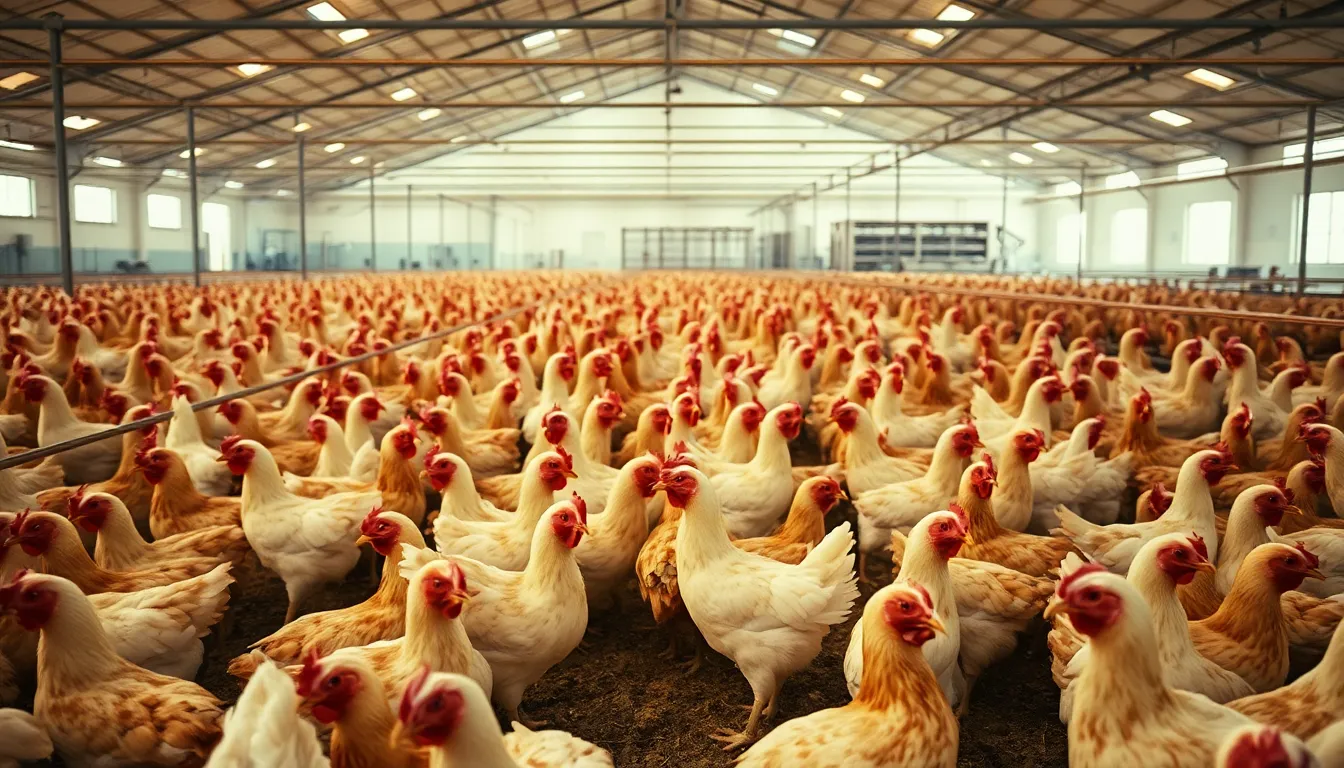Every day, the clucking world of chickens faces a staggering reality that might leave you scratching your head. With millions of these feathered friends meeting their untimely end, it’s hard not to wonder just how many chickens are sacrificed daily for our culinary cravings. Spoiler alert: the number is nothing short of jaw-dropping.
Table of Contents
ToggleOverview of Chicken Production
Chicken production encompasses the entire lifecycle of poultry, from hatching to processing. In the United States alone, over 25 billion chickens are raised annually for meat, often referred to as broilers. Producers focus on high efficiency to meet growing consumer demand, leading to significant daily slaughter numbers.
Daily, approximately 25 million chickens undergo processing to fulfill meat consumption needs. The increase in poultry consumption correlates with rising populations and dietary shifts toward protein-rich foods. Factors like breeding practices and factory farming contribute to rapid growth rates among chickens, with some reaching market weight in as little as six weeks.
Industries operate under strict regulations to ensure safety, although concerns persist regarding animal welfare in mass production settings. Methods of raising chickens vary, with conventional and organic practices offering distinct differences in treatment and diet. Understanding these practices sheds light on the ethical considerations of production.
Chickens provide a substantial portion of the protein intake for many diets worldwide. In 2022, chicken accounted for approximately 37% of all meat consumed in the U.S. This trend demonstrates consumer preference for chicken over other meats, fueled by its perceived affordability and versatility in cooking.
Producers continue to innovate with techniques that enhance yield and reduce costs while navigating ethical dilemmas and sustainability challenges. The commitment to increased production often emphasizes efficiency, impacting the overall treatment of chickens in the industry. Understanding these dynamics reveals the complexities behind the staggering number of daily chicken sacrifices.
Number of Chickens Killed Daily

The scale of chicken slaughter is immense. Each day, approximately 25 million chickens are killed in the United States alone, driven by a consistent consumer demand for chicken meat.
Global Statistics
Worldwide, the chicken industry is staggering. About 66 billion chickens are killed annually across the globe. This figure highlights the enormous scale of poultry farming and its significance in global meat consumption. In countries like Brazil and China, chicken production also contributes heavily to these statistics, with millions facing slaughter daily.
Factors Influencing Kill Rates
Several factors sway the rates of chicken slaughter. Demand for protein-rich diets propels numbers upward as populations grow. Breeding practices influence growth rates; some chickens reach market weight in just six weeks. Additionally, advancements in farming technology enhance efficiency, allowing producers to process more birds each day. Economic factors also play a role; fluctuating prices can impact how many chickens are raised and killed.
Methods of Chicken Slaughter
Various methods exist for slaughtering chickens, each with distinct practices and implications for animal welfare. Understanding these methods provides insight into the complexities of poultry production.
Conventional Methods
Conventional slaughter methods primarily involve stunning and then bleeding. Electrical stunning is common, where chickens receive a current that renders them unconscious. After stunning, processing continues with rapid severing of the carotid arteries, ensuring swift death. In many facilities, however, issues with improper stunning can lead to prolonged suffering. The industry’s focus on speed and efficiency often prioritizes production rates. Automation also plays a role, with machines handling numerous chickens per minute. This method has facilitated the processing of approximately 25 million chickens daily in the U.S.
Alternative Methods
Alternative slaughter methods emphasize humane treatment and animal welfare. Low-stress handling techniques increasingly gain popularity, involving calm environments during processing. These practices may include slower movement through processing lines, reducing anxiety in chickens. Some producers adopt the use of controlled-atmosphere killing, where chickens are exposed to gas mixtures that induce unconsciousness before bleeding occurs. These methods align with growing consumer concerns and ethical considerations in food production. Producers implementing humane practices often report better outcomes in meat quality and consumer satisfaction. As demand for ethically sourced meat continues to rise, alternative methods could reshape the industry landscape.
Impact on the Environment
Massive poultry production significantly affects the environment. Intensive chicken farming generates substantial waste, contributing to pollution. Approximately 25 million chickens killed daily translates to vast amounts of manure, which can contaminate soil and waterways if not managed properly.
Greenhouse gas emissions also play a crucial role in the environmental impact of chicken production. The poultry industry is responsible for 18% of all greenhouse gas emissions from livestock. A focus on efficient production methods often prioritizes yields over environmental considerations, leading to ecological degradation.
Land use requirements for chicken farming contribute to deforestation and habitat loss. The need for feed crops, like corn and soy, drives the clearing of forests, particularly in regions such as South America. This land conversion threatens biodiversity and disrupts ecosystems.
Water consumption is another vital aspect. Raising chickens requires considerable water resources for drinking and cleaning. Studies indicate that producing one kilogram of chicken meat demands around 4,300 liters of water, highlighting the strain on local water supplies.
Additionally, antibiotic use in poultry farming poses risks to environmental health. Antibiotics can leach into soil and water, fostering antibiotic-resistant bacteria, which endangers public health. This issue underscores the necessity for responsible farming practices and the prevention of overuse.
Efforts to adopt sustainable practices in the chicken industry are crucial for mitigating these impacts. Transitioning towards more humane and environmentally friendly methods fosters a more balanced interaction with the ecosystem. As consumer awareness grows, so does the demand for chicken produced with less environmental harm, pushing producers to innovate and adapt.
Ethical Considerations
Animal welfare remains a crucial concern in the chicken industry. Daily slaughter rates raise moral questions about the treatment of animals. In mass production settings, the efficiency of raising 25 million chickens daily often leads to neglect of humane practices. Traditional slaughter methods can result in prolonged suffering if procedures fail to comply with welfare standards.
Innovative practices aim to improve treatment and enhance the quality of life for chickens. Alternative methods focus on low-stress handling and controlled-atmosphere killing. These alternatives resonate with a growing consumer demand for ethically sourced meat, potentially influencing industry practices. Many producers report higher meat quality and customer satisfaction when adopting humane techniques.
Environmental impacts also complicate ethical considerations. Intensive farming produces significant waste, resulting in pollution and habitat degradation. Around 18% of livestock-related greenhouse gas emissions come from poultry production, raising urgency for sustainable practices. Furthermore, raising a kilogram of chicken demands approximately 4,300 liters of water, highlighting resource consumption issues.
Producers face pressure to address antibiotic use, which contributes to environmental challenges and antibiotic resistance. As awareness increases, consumers push for greater transparency in food sourcing. Prioritizing sustainability and animal welfare may drive fundamental changes in production methods. The industry’s future hinges on recognizing the ethical implications of daily slaughter numbers and adapting to meet consumer expectations.
The staggering number of chickens killed daily underscores the complexities of the poultry industry. As consumer demand for chicken continues to rise, the ethical and environmental implications of mass production can’t be ignored. Awareness of animal welfare and sustainable practices is growing among consumers, pushing producers to adapt.
The future of chicken farming may hinge on a balance between meeting demand and ensuring humane treatment. As innovations emerge and consumer preferences evolve, the industry faces a critical moment. Embracing transparency and sustainability could reshape the landscape of poultry production for the better.

